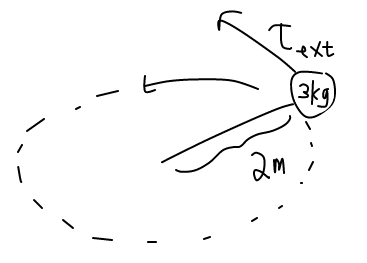An object with a mass of # 3 kg# is traveling in a circular path of a radius of #2 m#. If the object's angular velocity changes from # 1 Hz# to # 8 Hz# in # 5 s#, what torque was applied to the object?
1 Answer
It depends on whether it's a vertical loop or a horizontal loop, but let's assume it's horizontal and imagine a so-called "massless" string attached to the object.
Let's try drawing a Free-Body diagram for this:

Now, we can use a simple kinematics equation analog relating
Just like how:
#vecv_f = vecv_i + vecat#
... we have:
#\mathbf(vecomega_f = vecomega_i + vecalphat)#
So with this, we can find
#\mathbf(sumtau = Ialpha)#
Next, we need the inertia for a mass rotating about an axis. It should be
#sumtau_"ext"#
#= color(green)(I)color(highlight)(alpha)#
#= color(green)(mr^2)color(highlight)(((vecomega_f - vecomega_i)/t))#
#= color(green)(("3 kg")("2 m")^2)color(highlight)((("8 rad/s" - "1 rad/s")/"5 s"))#
#= color(blue)("16.8 N"cdot"m")#

